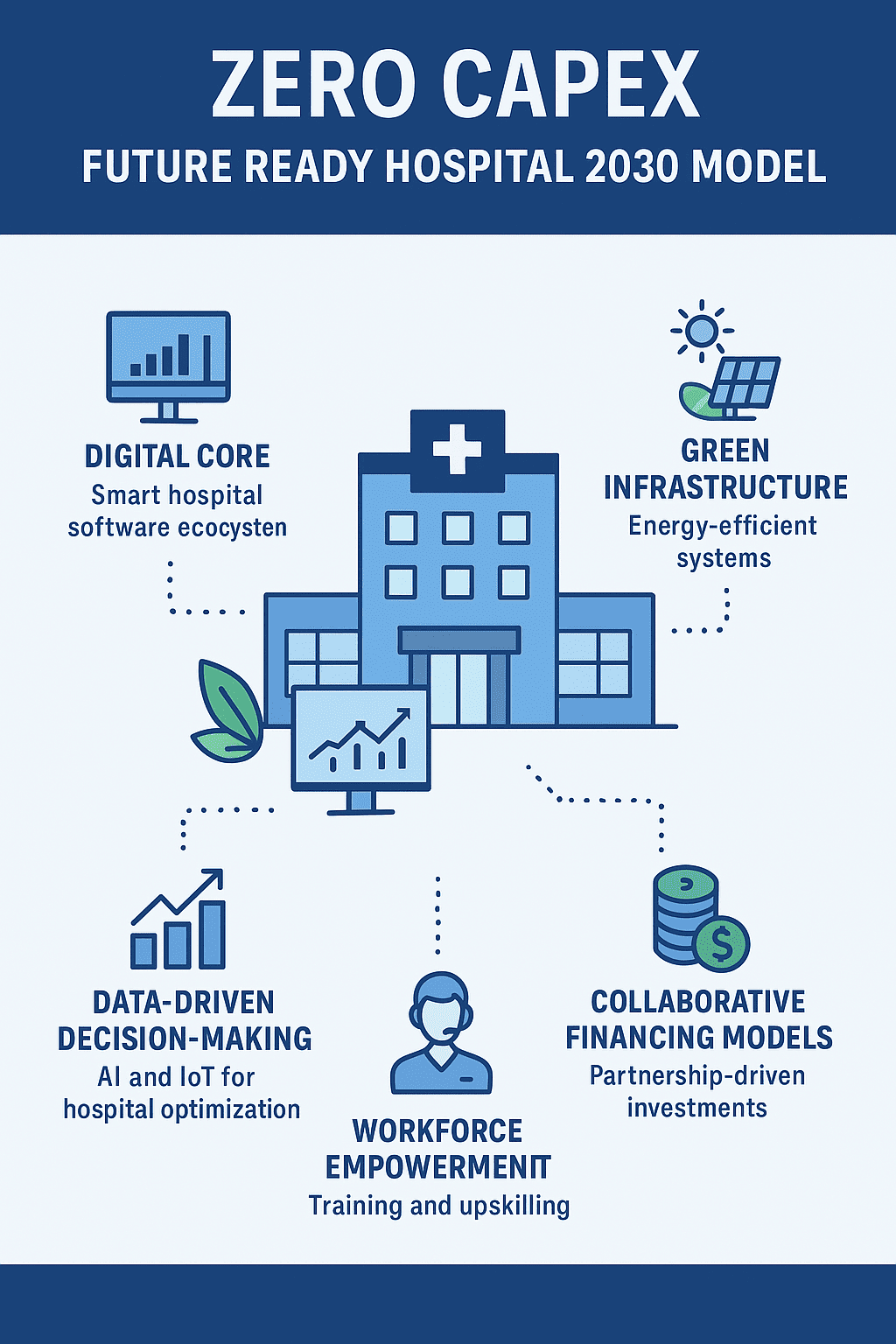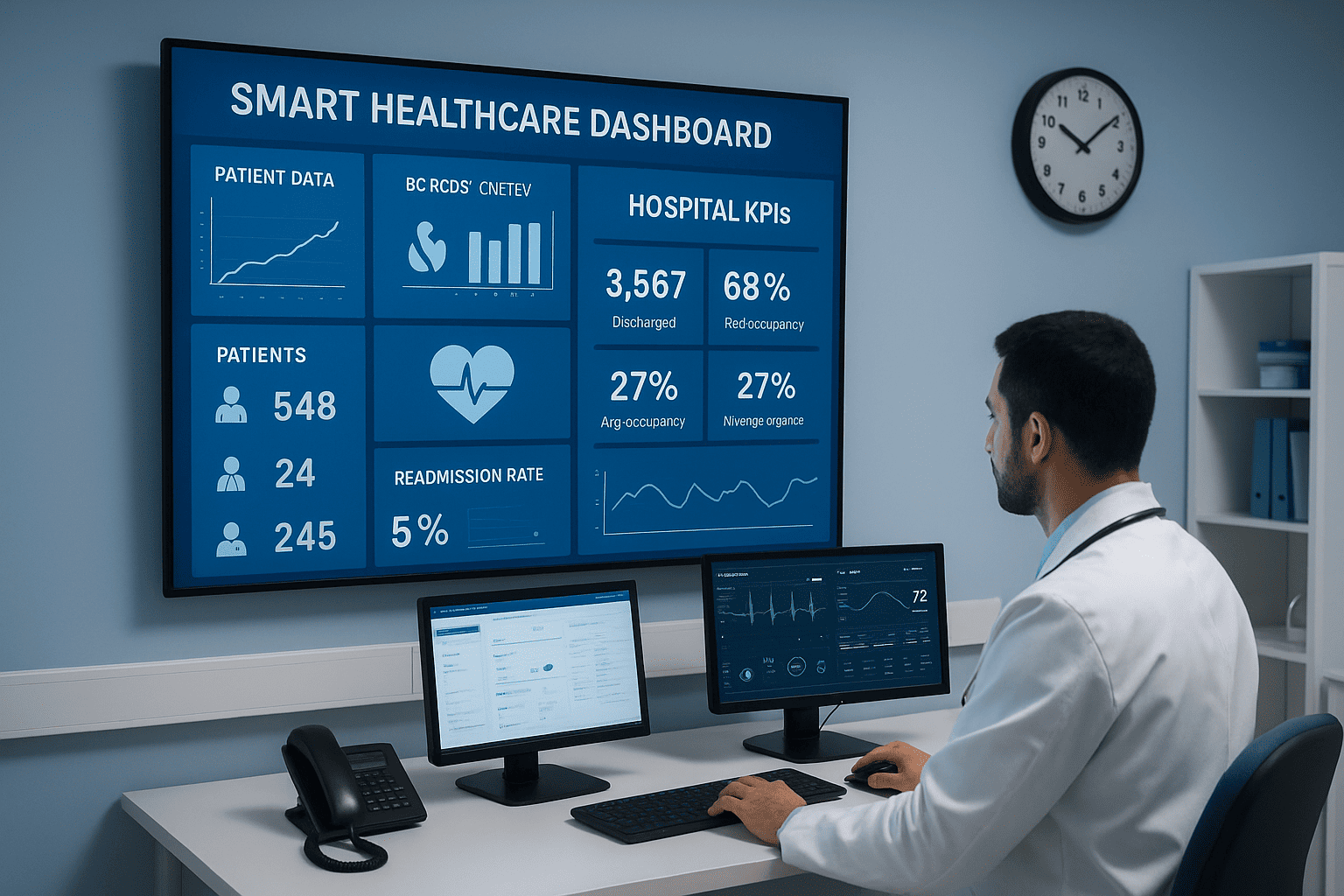
📑 Table of Contents
-
Introduction: The Coming Revolution in Tier-2 Healthcare
-
Understanding the Future Ready Hospital 2030 Model
-
Why Tier-2 Hospitals Struggle with Capex and Digitalization
-
Zero Capex Growth — The New Reality for Smart Hospitals
-
Key Components of the Future Ready Hospital 2030 Model
-
Case Insight: How Tier-2 Hospitals Can Adopt It
-
Benefits Beyond Cost Savings
-
Future Ready Hospital 2030 and the Role of Sustainability
-
Getting Started: Step-by-Step Transformation Plan
-
Final Thoughts: Turning Challenges into Growth Opportunities
1. Introduction: The Coming Revolution in Tier-2 Healthcare
India’s Tier-2 hospitals are standing at the edge of a historic shift. Patient expectations are changing rapidly, healthcare competition is increasing, and technology is reshaping how hospitals operate. Yet, many hospitals outside metros struggle with one barrier — capital expenditure (Capex).
The Future Ready Hospital 2030 model offers a groundbreaking path forward: enabling Tier-2 and Tier-3 hospitals to modernize, digitize, and scale without heavy upfront investment. It’s not just about surviving the next decade — it’s about thriving in it.
2. Understanding the Future Ready Hospital 2030 Model
The Future Ready Hospital 2030 is a framework designed for next-generation healthcare institutions. It integrates digital transformation, operational automation, and sustainability into a single growth strategy — all powered by innovative financing and shared-infrastructure models.
This model recognizes that most hospitals in Tier-2 India cannot afford multi-crore investments in new buildings, equipment, or IT systems. Instead, it focuses on “Zero Capex Growth” — where hospitals partner with technology and infrastructure providers who deploy solutions on a pay-per-use or subscription basis.
3. Why Tier-2 Hospitals Struggle with Capex and Digitalization
For decades, Tier-2 hospitals have faced challenges such as:
-
High cost of new medical technology (MRI, modular OTs, digital diagnostics)
-
Limited access to funding or low-margin loans
-
Low patient retention due to outdated infrastructure
-
Manual workflows leading to inefficiency and data silos
-
Lack of qualified technical staff for IT and compliance
These issues prevent smaller hospitals from competing with large corporate chains. But the Future Ready Hospital 2030 model breaks this cycle by making modernization financially achievable.
4. Zero Capex Growth — The New Reality for Smart Hospitals
“Zero Capex” doesn’t mean zero cost — it means no upfront investment. Hospitals can adopt advanced systems and infrastructure using flexible models such as:
-
OPEX-based digital health platforms (HMS, EMR, Telemedicine)
-
Equipment leasing & PPP-based diagnostics
-
Green hospital retrofitting through energy performance contracts
-
AI-driven automation tools offered on SaaS (Software-as-a-Service)
This model allows Tier-2 hospitals to become Future Ready Hospitals 2030 — with cloud-connected systems, energy-efficient operations, and patient-centric workflows — all financed through operational revenue instead of capital loans.
(External Resource: Learn more about OPEX vs. CAPEX financing models in healthcare at NITI Aayog’s Health Infra Reports)
5. Key Components of the Future Ready Hospital 2030 Model
a. Digital Core (Smart Hospital Software Ecosystem)
A unified digital backbone connecting HIS, LIS, EMR, and billing — accessible through mobile and web dashboards.
b. Green Infrastructure
Energy-efficient systems, solar power integration, water recycling, and smart HVAC for lower operating costs.
c. Data-Driven Decision-Making
AI and IoT sensors for predictive analytics in patient flow, inventory management, and preventive maintenance.
d. Collaborative Financing Models
Partner-driven investments where vendors install equipment or IT systems and recover costs through shared revenue or subscription.
e. Workforce Empowerment
Continuous training and upskilling programs for doctors, nurses, and admin teams on digital healthcare tools.
Each of these pillars strengthens the hospital’s ability to adapt, scale, and innovate — the very essence of a Future Ready Hospital 2030.
6. Case Insight: How Tier-2 Hospitals Can Adopt It
Imagine a 100-bed multi-specialty hospital in Bareilly struggling with patient record management, energy bills, and compliance audits. Instead of spending ₹1 crore on a new HIS and solar retrofit, the hospital collaborates with a Future Ready Hospital 2030 solution provider like Hospital Traders.
-
Digital Upgrade: HIS + EMR implemented via SaaS (monthly plan)
-
Energy Optimization: Solar and HVAC upgrades through an EPC partner
-
Smart Monitoring: IoT-based patient dashboards
-
Accreditation Support: NABH-ready documentation automation
Within six months, the hospital reduces admin costs by 25%, increases patient satisfaction by 40%, and achieves break-even without a single rupee of Capex.
( Link: Learn about Future Ready Hospitals 2030 → Future Ready Hospital 2030)
7. Benefits Beyond Cost Savings
The Future Ready Hospital 2030 model delivers benefits far beyond financial gains:
-
Enhanced Patient Experience: Digital records, mobile check-ins, and faster billing.
-
Operational Efficiency: Automated reports, reduced manual errors, and predictive maintenance.
-
Regulatory Compliance: Real-time monitoring ensures NABH/NABL readiness.
-
Environmental Impact: Reduced carbon footprint through green design.
-
Brand Reputation: Future-ready hospitals attract investors, insurers, and top medical talent.

8. Future Ready Hospital 2030 and the Role of Sustainability
No future-ready model is complete without sustainability. A green hospital is not only environmentally responsible but also economically smart.
Through energy-efficient systems, optimized lighting, smart HVAC, and renewable energy, hospitals can save ₹30–₹50 lakhs annually. When paired with digital transformation, the dual impact — cost savings plus compliance advantage — positions these hospitals for long-term success.
( Link: Read WHO’s guidelines on Sustainable Health Facility Design)
9. Getting Started: Step-by-Step Transformation Plan
-
Audit Current Operations – Identify inefficiencies in energy, data, and patient flow.
-
Define Growth Goals – Decide if the focus is on NABH, patient experience, or expansion.
-
Select Partners – Choose vendors offering OPEX-based solutions and zero-capex infrastructure upgrades.
-
Implement Digitally in Phases – Begin with EMR, then automation, then analytics.
-
Train Your Team – Make technology adoption part of daily workflow.
-
Track and Optimize – Use live dashboards for performance monitoring.
By following these steps, any Tier-2 hospital can begin its Future Ready Hospital 2030 journey with minimal disruption and maximum ROI.
🔍 Final Thoughts: Turning Challenges into Growth Opportunities
The Future Ready Hospital 2030 model is not just a futuristic concept—it’s today’s most urgent necessity. As India’s healthcare ecosystem undergoes a rapid digital and structural transformation, Tier-2 and Tier-3 hospitals stand at a decisive crossroads. The challenges of limited budgets, infrastructure constraints, and staffing shortages can no longer be solved by traditional models of capital-heavy expansion. The new era calls for Zero Capex Growth—a model where innovation, technology, and partnerships drive sustainable transformation without financial burden.
A Paradigm Shift in Healthcare Thinking
For decades, hospitals have believed that modernization equals massive investment—new buildings, expensive equipment, or large-scale digital systems. But the Future Ready Hospital 2030 model redefines that equation. Instead of owning every asset, hospitals can now access technology through subscription-based systems, leverage renewable energy partnerships, and collaborate with healthcare technology providers on performance-based outcomes.
This approach democratizes growth. A Tier-2 hospital in Bareilly, Panipat, or Coimbatore can now match the operational intelligence of a metro hospital—without spending crores upfront. Whether it’s through AI-driven patient management, IoT-enabled monitoring systems, or cloud-based hospital management software, the entry barrier has never been lower.
From Financial Burden to Financial Freedom
The biggest advantage of the Zero Capex model lies in its ability to convert fixed costs into operational efficiencies. Traditionally, hospitals had to invest heavily in equipment, maintenance, and digital infrastructure. But with the Future Ready Hospital 2030 framework, these costs are shared or eliminated through innovative partnership structures.
For example:
-
Instead of buying an MRI machine, a hospital can enter into a revenue-sharing model with an imaging partner.
-
Instead of paying upfront for an HIS (Hospital Information System), it can opt for a pay-per-use or SaaS-based model.
-
Instead of building its own solar infrastructure, it can sign a power purchase agreement with a renewable energy company.
These strategies release liquidity, improve cash flow, and allow hospital management to focus on what matters most—delivering better patient outcomes.
Sustainability: The Core of Future Readiness
The Future Ready Hospital 2030 model is deeply tied to the concept of sustainability. A hospital’s success in the coming decade won’t be measured only by patient volumes but also by its environmental and operational efficiency.
Green infrastructure—like solar rooftops, smart HVAC systems, and water recycling—reduces costs and enhances brand trust. Patients increasingly prefer institutions that reflect responsibility toward the planet. Likewise, integrating smart lighting, automated energy monitoring, and digital records minimizes waste and supports accreditation standards such as NABH and Green Hospital Certification.
In this ecosystem, sustainability isn’t an add-on—it’s a growth multiplier.
People + Technology = The Real Competitive Edge
Technology alone can’t make a hospital future-ready. The real transformation happens when people and processes evolve alongside it. Training healthcare staff to use digital systems, analyze data, and adapt to new workflows ensures smoother transitions and fewer disruptions.
In a Future Ready Hospital 2030, nurses access patient charts digitally, doctors review lab results in real time, and administrators monitor performance dashboards daily. This data-driven ecosystem enables proactive decision-making, improves patient experience, and builds organizational agility.
Moreover, when teams see how automation simplifies their workload—reducing paperwork, delays, and redundancies—it boosts morale and retention, solving one of the biggest Tier-2 challenges: staff turnover.
The Opportunity Ahead
Over the next three to five years, India’s healthcare landscape will reward those who innovate early. Hospitals that embrace Zero Capex Growth today will become tomorrow’s leaders—digital, efficient, and sustainable. The convergence of healthcare technology, renewable energy, and public-private partnerships will redefine what “affordable excellence” means in Indian healthcare.
The future belongs to hospitals that see disruption not as a threat but as an opportunity to lead. Every small step toward digital transformation—whether it’s adopting telemedicine, automating billing, or using AI for predictive diagnosis—brings your institution closer to becoming a Future Ready Hospital 2030.
A Call to Action
The future is already here. The question for every Tier-2 hospital is simple:
Will you wait and watch the healthcare revolution pass by—or will you act now, redefine your model, and lead as a Future Ready Hospital 2030?
Those who act today will not only survive—they will inspire a new era of patient-centered, financially sustainable, and technologically empowered healthcare across India.


